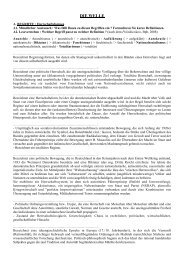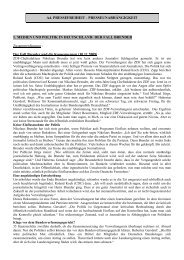Master 1 â English Elise Le Goff Tort law and compensation culture ...
Master 1 â English Elise Le Goff Tort law and compensation culture ...
Master 1 â English Elise Le Goff Tort law and compensation culture ...
- No tags were found...
Create successful ePaper yourself
Turn your PDF publications into a flip-book with our unique Google optimized e-Paper software.
<strong>Master</strong> 1 – <strong>English</strong><br />
<strong>Elise</strong> <strong>Le</strong> <strong>Goff</strong><br />
<strong>Tort</strong> <strong>law</strong> <strong>and</strong> <strong>compensation</strong> <strong>culture</strong><br />
General introduction: what is tort <strong>law</strong>?<br />
PART 1: The McDonald’s Coffee Case – 1992: a frivolous case?<br />
I. Presentation of the case : Stella Liebeck v. McDonald’s Corporation<br />
II. Please fill in the blanks with what you now know about the case :<br />
Stella L_____________ v. M________________’s Corporation, a.k.a the McDonald's coffee case <strong>and</strong> the hot coffee<br />
<strong>law</strong>suit, is a 1994 product liability <strong>law</strong>suit that became a flashpoint in the debate in the U.S. over t________<br />
reform. The brief summary that is often retold is similar to this: in February, ____________ (date), Liebeck, a 79<br />
year old woman from A____________________, New Mexico, ordered coffee from the d____________ through of<br />
a local McDonald’s restaurant, which she then s________________ on her lap. The hot coffee b_____________ her,<br />
<strong>and</strong> she subsequently s______________ McDonald’s. The jury awarded her $2.9 m________ in<br />
d_______________________. Based on this summary, the case has become emblematic of f_________________<br />
<strong>and</strong> outrageous l__________________ for many people <strong>and</strong> is often used as an example of the need for<br />
t_____________ reform in the United States legal system. The summary, however, omits a large number of<br />
relevant information <strong>and</strong> leads to many myths <strong>and</strong> mis__________________. For example many people thought<br />
Stella Liebeck was driving when the incident occurred, or that she was very lightly injured <strong>and</strong> sued McDonaldʼs<br />
only to get money. None of that is true, here are the true facts of the case.<br />
The person driving the car was Liebeckʼs gr<strong>and</strong>son Chris, who had parked the car so that Liebeck could add<br />
cream <strong>and</strong> sugar to her coffee. She placed the coffee cup between her k___________ <strong>and</strong> attempted to<br />
r__________________ the lid. In the process, she spilled the entire cup of coffee on her l___________. Liebeck<br />
was w______________ sweatpants; they absorbed the coffee <strong>and</strong> held it against her s____________. She was<br />
taken to the hospital where it was determined that she had suffered third degree burns. She r_______________<br />
in the hospital for 8 days while she underwent skin g______________. Two years of treatment followed. Liebeck<br />
sought to s______________ with McDonaldʼs for $20,000 to cover her m________________ costs, but the<br />
company offered $800. When McDonaldʼs refused to r____________ their offer, Liebeck f__________ suit.<br />
During the case it was discovered that McDonaldʼs r____________________ franchises to serve coffee at<br />
180-190 degrees Fahrenheit (82-88 C°). At that temperature, the coffee would cause a third degree burn in two to<br />
seven seconds. T_________________ by witnesses for McDonaldʼs revealed that:<br />
- consumers were not a____________ the coffee was so hot that there was a risk of serious burns.<br />
- McDonaldʼs did not i___________ customers of this risk <strong>and</strong> they could offer no explanation as to why<br />
there was no warning.<br />
- McDonaldʼs did not intend to reduce the temperature of its coffee.<br />
Documents obtained from McDonaldʼs also showed that in ten years, from 1982 to 1992, more that 700 other<br />
people were burned by McDonaldʼs coffee with varying degrees of severity. These incidents resulted in many<br />
other legal c_______________.<br />
The j____________ found that McDonaldʼs was 80% responsible for the accident, while Liebeck was 20%<br />
______ (prep) fault. They awarded her $200,000 in ________________ damages, which was then reduced<br />
__________ (prep) 20% to $160,000. In addition, they awarded her $2.7 million in _________________<br />
damages. However, the judge reduced this amount ________ (prep) $480,000: thus Liebeck was awarded<br />
$640,000 in total.<br />
However the amount she a______________ received from McDonaldʼs is u____________. Rather than<br />
a____________ the decision, McDonaldʼs entered into secret n______________ with Liebeck <strong>and</strong> came to a<br />
s___________________________. Summary adapted from an old version of en.wikipedia.org.<br />
III.<br />
Pairwork: in small groups of 2 or 3 students, ask each other the following questions:<br />
1. What is tort <strong>law</strong>?<br />
2. What is a frivolous <strong>law</strong>suit?<br />
3. Where <strong>and</strong> when did the McDonald’s Coffee take place? (use the past)<br />
4. Who was the plaintiff?<br />
5. What happened to Stella Liebeck? (the facts – use the past)<br />
6. Describe S. Liebeck’s injuries <strong>and</strong> hospitalization (what type, how long, the cost – use the past)<br />
7. Describe McDonald’s attitude (what was revealed during the trial – use the past)<br />
1
8. What was the verdict ? (damages – use the past)<br />
IV.<br />
Here is another more detailed summary of the case:<br />
There is a lot of hype about the McDonalds' scalding<br />
coffee case. No one is in favor of frivolous cases of<br />
outl<strong>and</strong>ish results; however, it is important to underst<strong>and</strong><br />
some points that were not reported in most of the stories<br />
about the case. McDonalds coffee was not only hot, it<br />
was scalding -- capable of almost instantaneous<br />
destruction of skin, flesh <strong>and</strong> muscle.<br />
Critics of civil justice often mock Stella Liebeck, calling the<br />
McDonald’s coffee case laughable <strong>and</strong> frivolous. However,<br />
it was McDonald’s own testimony <strong>and</strong> action, <strong>and</strong> the<br />
severity of the plaintiff’s injuries, that led a jury to rule<br />
against the company.<br />
Facts<br />
Stella Liebeck of Albuquerque, New Mexico, was in the<br />
passenger seat of her gr<strong>and</strong>son's car when she was<br />
severely burned by McDonalds' coffee in February 1992.<br />
Liebeck, 79 at the time, ordered coffee that was served in<br />
a styrofoam cup at the drive through window of a local<br />
McDonald’s.<br />
After receiving the order, the gr<strong>and</strong>son pulled his car<br />
forward <strong>and</strong> stopped momentarily so that Liebeck could<br />
add cream <strong>and</strong> sugar to her coffee. (Critics of civil justice,<br />
who have pounced on this case, often charge that<br />
Liebeck was driving the car or that the vehicle was in<br />
motion when she spilled the coffee; neither is true.)<br />
Liebeck placed the cup between her knees <strong>and</strong> attempted<br />
to remove the plastic lid from the cup. As she removed the<br />
lid, the entire contents of the cup spilled into her lap.<br />
Stella Liebeck’s injury <strong>and</strong> hospitalization:<br />
The sweatpants Liebeck was wearing absorbed the coffee<br />
<strong>and</strong> held it next to her skin. A vascular surgeon<br />
determined that Liebeck suffered full thickness burns (or<br />
third-degree burns) over 6 percent of her body, including<br />
her inner thighs, perineum, buttocks, <strong>and</strong> genital <strong>and</strong> groin<br />
areas. She was hospitalized for eight days, during which<br />
time she underwent skin grafting. Liebeck, who also<br />
underwent debridement treatments, sought to settle her<br />
claim for $20,000, but McDonald’s refused.<br />
McDonald’s attitude:<br />
During discovery, McDonalds produced documents<br />
showing more than 700 claims by people burned by its<br />
coffee between 1982 <strong>and</strong> 1992. Some claims involved<br />
third-degree burns substantially similar to Liebeck’s. This<br />
history documented McDonalds' knowledge about the<br />
extent <strong>and</strong> nature of this hazard.<br />
McDonald’s also said during discovery that, based on a<br />
consultants advice, it held its coffee at between 180 <strong>and</strong><br />
190 degrees fahrenheit to maintain optimum taste. He<br />
admitted that he had not evaluated the safety<br />
ramifications at this temperature. Other establishments<br />
sell coffee at substantially lower temperatures, <strong>and</strong> coffee<br />
served at home is generally 135 to 140 degrees.<br />
Damaging testimony:<br />
Further, McDonalds' quality assurance manager testified<br />
that the company actively enforces a requirement that<br />
coffee be held in the pot at 185 degrees, plus or minus<br />
five degrees. He also testified that a burn hazard exists<br />
with any food substance served at 140 degrees or above,<br />
<strong>and</strong> that McDonald’s coffee, at the temperature at which it<br />
was poured into styrofoam cups, was not fit for<br />
consumption because it would burn the mouth <strong>and</strong> throat.<br />
The quality assurance manager admitted that burns would<br />
occur, but testified that McDonalds had no intention of<br />
reducing the "holding temperature" of its coffee.<br />
Plaintiffs' expert, a scholar in thermodynamics applied to<br />
human skin burns, testified that liquids, at 180 degrees,<br />
will cause a full thickness burn to human skin in two to<br />
seven seconds. Other testimony showed that as the<br />
temperature decreases toward 155 degrees, the extent of<br />
the burn relative to that temperature decreases<br />
exponentially. Thus, if Liebeck's spill had involved coffee<br />
at 155 degrees, the liquid would have cooled <strong>and</strong> given<br />
her time to avoid a serious burn.<br />
McDonald’s asserted that customers buy coffee on their<br />
way to work or home, intending to consume it there.<br />
However, the company’s own research showed that<br />
customers intend to consume the coffee immediately<br />
while driving.<br />
McDonald’s also argued that consumers know coffee is<br />
hot <strong>and</strong> that its customers want it that way. The company<br />
admitted its customers were unaware that they could<br />
suffer third degree burns from the coffee <strong>and</strong> that a<br />
statement on the side of the cup was not a "warning" but<br />
a "reminder" since the location of the writing would not<br />
warn customers of the hazard.<br />
The verdict:<br />
The jury awarded Liebeck $200,000 in compensatory<br />
damages. This amount was reduced to $160,000 because<br />
the jury found Liebeck 20 percent at fault in the spill. The<br />
jury also awarded Liebeck $2.7 million in punitive<br />
damages, which equals about two days of McDonalds'<br />
coffee sales.<br />
Post-verdict investigation found that the temperature of<br />
coffee at the local Albuquerque McDonalds had dropped<br />
to 158 degrees fahrenheit.<br />
The trial court subsequently reduced the punitive award to<br />
$480,000 -- or three times compensatory damages --<br />
even though the judge called McDonalds' conduct<br />
reckless, callous <strong>and</strong> willful.<br />
Subsequent to remittitur, the parties entered into a secret<br />
settlement which has never been revealed to the public,<br />
despite the fact that this was a public case, litigated in<br />
public <strong>and</strong> subjected to extensive media reporting.<br />
http://www.lect<strong>law</strong>.com/files/cur78.htm<br />
-----<br />
excerpted from ATLA fact sheet. © 1995, 1996 by<br />
Consumer Attorneys of California<br />
Please match the definitions below with the underlined words from the above article:<br />
1. extremely hot, burning hot:<br />
2
2. court of first instance where most civil <strong>and</strong> criminal cases begin <strong>and</strong> where the facts are established:<br />
3. money to pay for the actual cost of an injury or loss:<br />
4. also called exemplary damages --intended to deter the defendant <strong>and</strong> others from engaging in similar<br />
conduct:<br />
5. someone who brings a legal action against another person in a court of <strong>law</strong><br />
6. something that may be dangerous, or cause accidents or problems<br />
7. an official request for money that you think you have a right to<br />
8. to give evidence, under oath, as a witness in a court of <strong>law</strong>:<br />
9. evidence presented orally by witnesses during trials.<br />
10. to give an official decision<br />
11. to give money following an official decision by a court<br />
12. a legal decision<br />
13. an agreement to end a legal argument, in which one party agrees to pay money to the other party so that the<br />
problem is not continued in court<br />
14. to negotiate to end an argument:<br />
15. irresponsible:<br />
16. cruel:<br />
17. intentional, deliberate:<br />
18. ruling by a judge to lower the amount of damages granted by a jury in a civil case<br />
V. Other helpful <strong>Le</strong>gal vocabulary words:<br />
1. A witness: a person giving sworn testimony to a court of <strong>law</strong> or the police.<br />
2. To sue : to bring a civil action against someone<br />
3. An action : A <strong>law</strong>suit brought to enforce, redress, or protect rights of private litigants—the plaintiffs <strong>and</strong> the<br />
defendants—not a criminal proceeding<br />
4. Negligence : a failure to exercise the care that a reasonably prudent person would exercise in like<br />
circumstances.[1] The area of tort <strong>law</strong> known as negligence involves harm caused by carelessness, not<br />
intentional harm<br />
5. <strong>Tort</strong> : A tort, in common <strong>law</strong> jurisdictions, is a civil wrong. <strong>Tort</strong> <strong>law</strong> deals with situations where a person's<br />
behavior has unfairly caused someone else to suffer loss or harm. A tort is not necessarily an illegal act but<br />
causes harm.<br />
6. A plaintiff : also known as a claimant, is the term used for the party who initiates a <strong>law</strong>suit (also known as<br />
an action) before a court. The other party is called a defendant.<br />
Now please fill in the blanks:<br />
In this case the p____________ was Mrs Liebeck. She s___________ McDonald’s for damages, saying the<br />
company had been n______________ in serving her coffee that was too hot. The jury heard much damaging<br />
t________________ from w____________________ even those called by the d___________________<br />
McDonald’s Corporation, <strong>and</strong> finally r_______________ that Mrs Liebeck should receive both<br />
c________________________ <strong>and</strong> p___________________ damages.<br />
VI. Asking questions:<br />
Student A: use the words below to formulate questions. Remember to use the past tense.<br />
Student B: answer your partner’s questions using the numbers below when necessary (<strong>and</strong> making full<br />
sentences).<br />
Questions:<br />
Background information about the accident:<br />
1. When / buy coffee / McDonald’s drive<br />
through?<br />
2. …. Seriously burned?<br />
3. Stella Liebeck / old?<br />
4. How long / stay in hospital?<br />
5. How / treatment last?<br />
6. How / treatment cost?<br />
Damages:<br />
1. How / money / Stella Liebeck /<br />
McDonald’s?<br />
2. How / McDonald’s / offer?<br />
3. How / jury / award / compensatory<br />
damages?<br />
4. How / jury / award / punitive damages?<br />
5. How / judge / reduce / award?<br />
6. You / know / much / receive / finally?<br />
Coffee temperature:<br />
1. temperature / coffee / McDonald’s / sell?<br />
2. That temperature / dangerous?<br />
3. Many people / burn / McDonald’s coffee?<br />
4. Temperature / coffee / at home?<br />
5. Temperature / Stella Liebeck’s case?<br />
3
Answers: 700 - $200,000 -3 rd – 135F° - $20,000 – 20% - 180/190 F° - 2 years - $800 – 8 days - 1992<br />
VII.<strong>Tort</strong> reform: what does it mean?<br />
<strong>Tort</strong> reform refers to proposed changes in common <strong>law</strong> civil justice systems that would reduce tort litigation or damages.<br />
<strong>Tort</strong> actions are civil common <strong>law</strong> claims created to compensate wrongs <strong>and</strong> harm done by one party to another's<br />
person, property or other protected interests (e.g. physical injury or reputation, under libel <strong>and</strong> sl<strong>and</strong>er <strong>law</strong>s).<br />
In the United States tort reform is a contentious political issue. US tort reform advocates propose, among other things,<br />
procedural limits on the ability to file claims, <strong>and</strong> capping the awards of damages. Supporters of the existing tort system,<br />
including consumer advocates, argue that reformers have mis-stated the existence of any real factual issue <strong>and</strong> criticize<br />
tort reform as disguised corporate welfare. http://en.wikipedia.org/wiki/<strong>Tort</strong>_reform<br />
Match the definitions with the underlined words:<br />
1. claims, <strong>law</strong>suits, legal proceedings<br />
2. important topic for debate<br />
3. give (someone) something in recognition of loss, suffering, or injury incurred.<br />
4. likely to cause disagreement or controversy<br />
5. place a limit on (prices, expenditure, etc.)<br />
6. people who publicly support or recommend a particular cause or policy (the definition applies to two<br />
words in the article).<br />
VIII. Grammar: traduire devoir, falloir<br />
1.Stella Liebeck aurait du être plus prudente.<br />
2.Vous devriez essayer de lire en anglais.<br />
3.Tu devrais acheter un dictionnaire, tu aurais du en acheter un qu<strong>and</strong> tu étais à Londres.<br />
4.Vous devez être déçu.<br />
5.Comme ils ont du être heureux de la voir.<br />
6.Faut-il que vous travailliez tous les samedis?<br />
7.Il devait au moins avoir 51 ans qu<strong>and</strong> son fils est né.<br />
8.Il faudra que tu me dises qui nous devrions inviter.<br />
IX.<br />
Listening: Democracy Now interviews Stella Liebeck’s daughter<br />
Please fill in the blanks with the words that you hear:<br />
AMY GOODMAN: We’re broadcasting this week from Park City, Utah, where the Sundance Film Festival is in full<br />
swing. Today we spend the hour on one of the most provocative films at the festival. It begins by looking at a<br />
famous case that, well, most everyone seems to have heard of, but gives it a very different spin. The film is<br />
called Hot Coffee.<br />
It tells the story of Stella Liebeck. She was 79 years old. She made national headlines when she _________<br />
McDonald’s after spilling a _______________ cup of hot coffee on her ___________. The ____________ had the<br />
whole country talking — <strong>and</strong> many laughing.<br />
But what most people don’t know is that Stella suffered third-degree burns on 16 percent of her body. And you<br />
also may not know that corporations have spent millions of dollars distorting the story to promote ____________<br />
reform <strong>and</strong> alter our country’s justice system.<br />
Stella Liebeck passed away in 2004 at the age of 91. We’re joined now by her daughter Judy <strong>and</strong> her son-in-<strong>law</strong><br />
Charles Allen.We welcome you both to Democracy Now!<br />
JUDY LIEBECK: Thank you.<br />
CHARLES ALLEN: Thank you.<br />
AMY GOODMAN: Hot Coffee is the name of this documentary, <strong>and</strong> it’s based on your mother’s case. Judy, tell<br />
us what happened. What day was it? And really explain. We heard your mother in this documentary when she<br />
was filmed talking about it. Talk about it yourself.<br />
4
JUDY LIEBECK: Well, whoever I talk to, they don’t have the right story. So I always ask, "What do you think<br />
happened?" What really happened was that my nephew was driving the car, not my mother. They drove into a<br />
McDonald’s, got coffee <strong>and</strong> a meal, drove into the parking lot. There were no cup holders in the car, so my<br />
mother steadied the cup between her ___________ <strong>and</strong> peeled off the _______. The whole cup collapsed.<br />
The temperature — McDonald’s __________________ that their temperature be held around 187 degrees.<br />
AMY GOODMAN: In a styrofoam cup.<br />
JUDY LIEBECK: In a styrofoam cup. And styrofoam will __________ at that temperature. She went to the<br />
hospital. We thought, oh, she’s in for observation overnight, no problem. But she was in for ______________<br />
days. She had ___________-degree burns. She could not —- you could not touch that area. She had to have a<br />
sheet held up. She –<br />
AMY GOODMAN: The pictures that are shown in the film are gruesome.<br />
JUDY LIEBECK: They’re very gruesome.<br />
AMY GOODMAN: Her _____________.<br />
JUDY LIEBECK: Yes. She had ___________ grafts. And the skin — when they started talking about skin grafts,<br />
that’s when she became _________________ about her money, because she had moved from Tucson to<br />
_________________. She wanted to buy a little house. And she thought all of her money would go, because<br />
Medicare was only going to pay 80 percent, <strong>and</strong> so she would have to pay ________ percent. And we started<br />
thinking, why is McDonald’s _____________ not paying for the medical? I have insurance on my home. If<br />
someone comes in <strong>and</strong> breaks an arm or hurts themselves, I expect my insurance to pay for it. That’s what I’m<br />
paying insurance for.<br />
So, we wrote a letter to McDonald’s. Chuck <strong>and</strong> I wrote a letter to McDonald’s, asking them to ___________ her<br />
medical <strong>and</strong> to ___________ the temperature on the coffee, because it seemed not reasonable that someone<br />
would have this kind of an ___________ from a cup of coffee. They came back with an offer of —- what was at<br />
that point $10,000 in medical, they came back with an offer of $_______. And we were just appalled. We wrote<br />
another letter, hadn’t heard from them, started getting very angry about this whole situation, <strong>and</strong> contacted a<br />
<strong>law</strong>yer, searched for a <strong>law</strong>yer that had already had a case against McDonald’s. And –<br />
AMY GOODMAN: A similar case? A case where someone was ___________ by hot coffee?<br />
JUDY LIEBECK: A similar case, yes. Yes, six years before. And that —<br />
http://www.democracynow.org/2011/1/25/do_you_know_the_full_story<br />
Part 2: Donoghue v. Stevenson: How a snail changed product liability <strong>law</strong>.<br />
I. Presentation of the case:<br />
Key words: l<strong>and</strong>mark case, common <strong>law</strong>, neighbor principle or duty of care breach of duty, negligence, product<br />
liability <strong>law</strong>suit, no win no fee or conditional fee system, personal injury.<br />
II.<br />
Summary:<br />
It is generally considered that the single most significant precedent for the <strong>law</strong> as it today relates to product liability claims<br />
was set in 1932 in the now famous case of Donoghue v. Stevenson. During this case the bulk of the legal principles which<br />
relate to product liability <strong>law</strong> as it still st<strong>and</strong>s were laid down in a l<strong>and</strong>mark legal ruling.<br />
The grievance of the product liability claimant in Donoghue v. Stevenson, Mrs Mary Donoghue, arose out of an incident where<br />
after buying a bottle of ginger beer from a Cafe <strong>and</strong> drinking most of the contents she found that the bottom of the bottle<br />
contained the decomposing remains of a snail.<br />
What made her product liability claim so historically significant was that she sought <strong>compensation</strong> from the manufacturer of<br />
the ginger beer (Stevenson), with whom she had no explicit contract. Her product liability claim outlined how she felt that she<br />
was owed personal injury <strong>compensation</strong> for both the nervous shock she had suffered as a result of the defect <strong>and</strong> the gastroenteritis<br />
she claimed to have developed from drinking it.<br />
(…) In the House of Lords Donoghue's personal injury solicitor successfully argued his client's case <strong>and</strong> won the single most<br />
important ruling to date in British product liability claim <strong>law</strong>. Lord Atkin's ruling still forms the basis of UK product liability<br />
5
claim <strong>law</strong> today: "The complainant has to show that he has been injured by the breach of duty owed to him in the<br />
circumstances by the defendant to take reasonable care to avoid such injury." The key legal principle decided by the Atkin in<br />
the case was the one of duty of care, or the 'neighbour principle'.<br />
His definition of neighbour is absolutely crucial to underst<strong>and</strong>ing the complexities of product liability claim <strong>law</strong>: "There must<br />
be, <strong>and</strong> is, some general conception of relations giving rise to a duty of care, of which the particular cases found in the books<br />
are but instances. ... The rule that you are to love your neighbour becomes in <strong>law</strong> you must not injure your neighbour; <strong>and</strong> the<br />
<strong>law</strong>yer's question: Who is my neighbour? receives a restricted reply. You must take reasonable care to avoid acts or<br />
omissions which you can reasonably foresee would be likely to injure your neighbour. Who, then, in <strong>law</strong>, is my neighbour? The<br />
answer seems to be persons who are so closely <strong>and</strong> directly affected by my act that I ought reasonably to have them in<br />
contemplation as long as so affected when I am directing my mind to the acts or omissions that are called in question."<br />
With that decision, it became inscribed in UK <strong>law</strong> that manufacturers, not only those businesses the consumer has an explicit<br />
contract with, had a liability to all UK consumers under the terms of the neighbour principle.'Just as thous<strong>and</strong>s of UK<br />
consumers would go on to do afterwards, Mrs Mary Donoghue successfully won personal injury <strong>compensation</strong> from the<br />
manufacturer of the ginger beer.<br />
http://www.youclaim.co.uk/product-liability-claim-<strong>law</strong>-origins.htm<br />
6



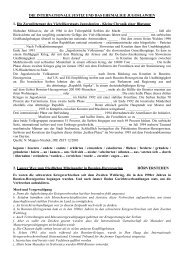

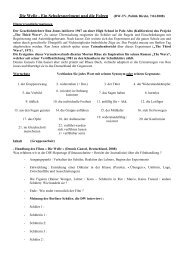

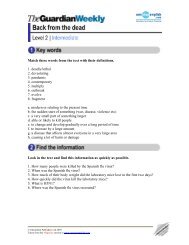
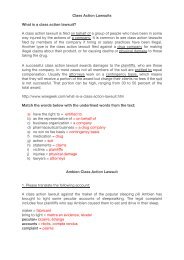

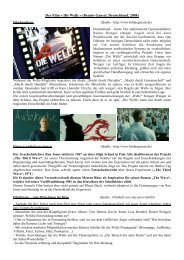


![DAS BUNDESVERFASSUNGSGERICHT [BVG] – ÜBUNGEN A ...](https://img.yumpu.com/21092838/1/184x260/das-bundesverfassungsgericht-bvg-ubungen-a-.jpg?quality=85)
